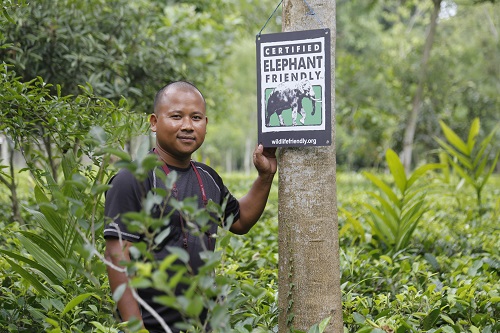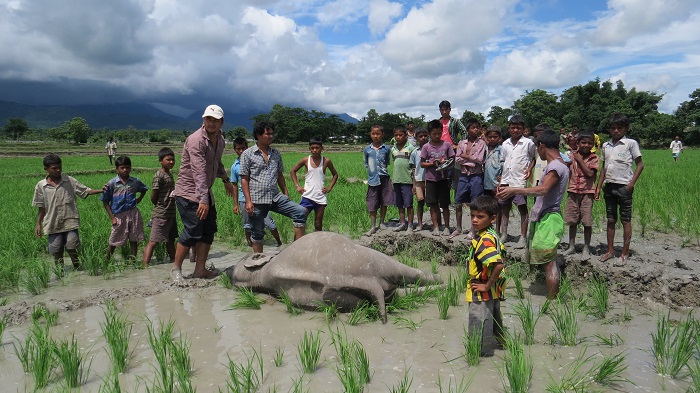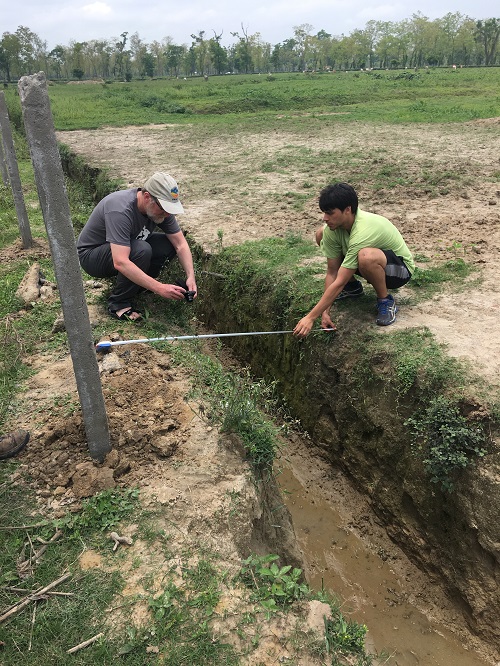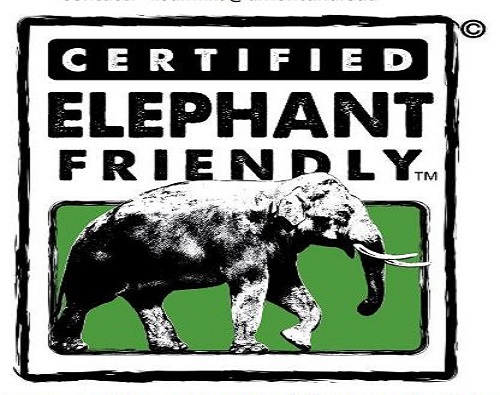This certification program is making your tea sessions more impactful. Find out how.
An edited version of this article was published in Nature inFocus on Jan 24, 2019.
There are many words you may use to describe your tea- milky, fruity, light, full. But a descriptor you would never think of is calling your tea elephant friendly.
Our cuppa has definitely evolved a lot in the last couple of years. The quintessential chai is now being overlooked for its greener version, although purists would argue otherwise. In general, we are being encouraged to drink more tea – hot or cold. While we do seem to indulge a lot in the drink and its health merits, our conversations stop at the cup and rarely make it to the source. Even when they do, tea farms are discussed in the context of climate change and the social issues around them, but biodiversity and ecological impacts do not make much of an appearance in these discussions.
However, a certification program is making sure all that is about to change. At the World Tea Expo held between June 12 and June 15, 2017, at Las Vegas, Wildlife Friendly Enterprise Network (WFEN), and the University of Montana -Broader Impacts Group introduced the world’s first Certified Elephant Friendly™ Tea that was grown in Assam. Since the expo, the certification program has added another tea estate from Darjeeling, and gotten people to pay attention to elephant populations as well as their choice of tea. Did you ever expect these two words in one sentence? Let’s find out how they connect.

Certified Elephant Friendly™ Tea farmer Tenzing Bodosa, the first small acreage farmer to be awarded this certification. Photograph: Stephen Styris/U. Montana
Why Elephants?
It is a known fact that Asian elephants are endangered species. Their population has declined by 50% over the last three generations, and the numbers continue to dwindle. Factors such as loss of habitat, human-elephant conflicts and poaching contribute to this decline. In fact, it has been noted that elephants now have only about 15% of their original land area to move about.
These natural corridors where elephants move are essential not just to maintain populations and provide natural habitat linkages; they also support other species like the Royal Bengal tigers.
“The ‘home range’ of an elephant herd can vary from an average of about 250 sq km (in Rajaji National Park) to over 3500 sq km (in the highly degraded, fragmented landscapes of West Bengal). Research shows that the more forest habitat is degraded, the farther an elephant herd has to roam in search of food and water,” elaborates this article by the Wildlife Trust of India. This further movement, in turn, leads to increased cases of human-elephant conflict as they move into human occupied spaces.
Many of the surrounding areas in these natural habitats are tea estates. Lisa Mills of the University of Montana, Broader Impacts Group who helped facilitate the development of standards for thiscertification program with expert inputs, explains how they encouraged elephant conservation in tea farms. “I had worked on a conservation project in the Bhutan- India border region, so we had an idea about what was happening with respect to elephants, especially deaths of elephants. With the help of about 120 volunteers, we mapped out elephant movements and mortality. We found a high number of deaths that were associated with agricultural practices, particularly in tea estates and small tea grower lands,” she shares.
Mills adds that some of the issues were electrocution of elephants from power lines or electrified fencing not installed in compliance with safety standards, improper storage and use of chemicals, as well as drainage ditches that trapped younger elephants. “We found that a lot of elephants were poisoned. When the bodies were tested, chemicals often matched those used in tea agriculture, basically chemical herbicides, pesticides and fertilizers. We also found a lot of human-elephant conflict in the tea worker lines, and just outside the farms. Elephants are attracted to tea estates and areas within which have quieter spots to have babies or rest during the day. When they move at night to a source of water, forests, or to forage in crop fields, they are actually trying their best to avoid conflict with humans,” she explains.
While Mills was not aware of the work WFEN was doing at the time, she realised that by involving the community to address these issues, it was possible to come up with a concrete plan of action. “In 2012 we had a group of tea growers come together to talk about elephant conservation in Assam. It was an enlightening experience for us because we found that while tea growers do care about elephants, they don’t have the bandwidth to work on conservation. We realised there have to be financial incentives for them, as they are struggling with various other issues.“
Mills got to know about WFEN and contacted Executive Director and Co-founder, Julie Stein to turn this program into a certification which could benefit tea growers and the elephant populations. Good tea and conservation in equal measure- now that’s a good blend.

Electrocutions of elephants are all too frequent in the tea growing region of Assam, India. The Elephant Friendly™ standards of compliance include the safe use of electrified fencing and the monitoring of sagging power lines that pose a safety hazard to passing elephants. Photograph: Subit Sawra/U. Montana
Being Elephant Friendly™.
The path to becoming certified, Mills shares, depends on multiple factors. Proper use, storage and disposal of chemicals, ensuring ditches within farmlands are enclosed, minimal fencing in elephant corridors, addressing electrocution hazards- these are some of the points the certification committee looks at. While addressing issues with chemicals rank as a topmost priority, a close second is human elephant conflict. “Elephants tend to have known movement patterns, so we ask the tea estates to record, track and watch the patterns. If they observe that elephants move around say 5 pm as a herd to get water, we ask them to plan their activities such that workers are not blocking that movement. Not just the workforce, we also hope that the community members understand that the corridors elephants use need to be kept open. Blocking it with crowds or gatherings, trucks and noises is what causes the problem,” Mills shares. While these are some of the general guidelines, the team provides a specific plan based on the existing practices of a tea farm.
Dr Scott Mills, Conservation Biologist and Wildlife Biology Professor at the University of Montana is studying the certification to understand its impact on ground. The team hopes that over time, as more tea farms become Certified Elephant Friendly™, they will see a positive effect on the elephant populations in the region.
The Farms
The Elephant Friendly™ certification program has not only managed to bring forth the issue of conservation; it has also managed to highlight the efforts of farms that were already prioritising the safety of elephants. Tenzing Bodosa, the first farmer to obtain certification, approached Lisa Mills even before the program was formalized to understand how he could make his farms a better place for the species.
Similarly, Sonia Jabbar, owner of the Nuxalbari Tea Estate which is also the first large tea estate to obtain this certification, shares that her steps towards creating a safe environment for elephants began about seven years ago. Perplexed by the constant news of elephant deaths and conflicts around her estate, Jabbar decided to take matters into her own hands.
“Elephant conservation at our estate has three parts to it. The first is the forests. We are setting aside land in our estate where we grow native species, which elephants can feed on and will also help us improve the biodiversity of our land. The second aspect we have come up with is called the “Haathi Saathi” program. This is an educational program wherein through stories, songs, and skits we teach children the importance of conservation, particularly elephants. The third is involving chaukidars or the estate guards. When they see elephants coming, they ensure people do not block the way or chase them- this works as an early warning system,” Jabbar explains.
She is now working on setting up a compensatory mechanism for crop loss due to elephant movements, and engaging farmers from nearby areas in the conservation activities. Both Jabbar and Bodosa practice organic tea farming. “You can’t be certified if your consciousness is not ready for it. You have to familiarize yourself with what is happening around you. Managers and the workforce in tea estates are stressed about their day to day work; so you need to break down the concept of conservation to them. This is more an educational process,” shares Jabbar.

University of Montana professor Scott Mills and his PhD student Alex Kumar measure a tea estate drainage ditch. A number of elephants die annually in tea estate ditches while trying to cross over, especially young calves. The design recommendations have not changed since the 1800s. Photograph: Lisa Mills/U. Montana
Conservation in my cup
WFEN has also created certification programs for coffee along with other products to support various species and raise awareness among consumers. “You have just about a few seconds to get the consumer’s attention. People look at these labels, and their curiosity is piqued. They want to dig deeper and understand what ‘wildlife friendly’ means or how can a tea be ‘elephant friendly’. And then suddenly there are these rich stories that unfold, about decades of work in some cases,” says Julie Stein, Executive Director and Co-founder of WFEN.
“It’s not intuitive to consumers that elephants are collateral damage in the tea industry. This is the first time they are thinking about the agricultural tea sector as being connected to wild elephants,” she adds.
Tea estates are now coming forward wanting to participate in this program as they slowly understand its importance. Elephant Friendly™ certification is also opening up markets for these tea growers, where consumers make conscious choices and appreciate their products. The teas are available in select stores across the US, and at Wild Kaapi (of course, this is Wild Tea) in India. There is also a wave of interest in London. The team has created a tea distribution company called Elephant Origins where a percentage of every sale goes back to support this program.
Wildlife Friendly Enterprise Network has been working on including wildlife in our broader dialogues about sustainability for a decade now. One of the bigger challenges, Stein shares, has been making that connection obvious to people. “There are no uniform definitions when it comes to sustainability. Many companies do not see wildlife and habitat as part of this definition. We have an expression called “The canary in the coal mine” here in the U.S. If you send a canary down to the coal mine and it dies, you know something is wrong in the mine. If elephants aren’t thriving anymore in a place where they used to, it is important to know the reason. That’s going to tell you about the ecosystem, and how it will impact human health as well. That is one of the messages that we are trying to get out there- that wildlife is part of the landscape. We share the same resources and are interdependent. We are all in this together.“
For more information, visit: Elephant Friendly™ Tea and the Wildlife Friendly Enterprise Network.
Featured Image : Courtesy Lisa Mills.
